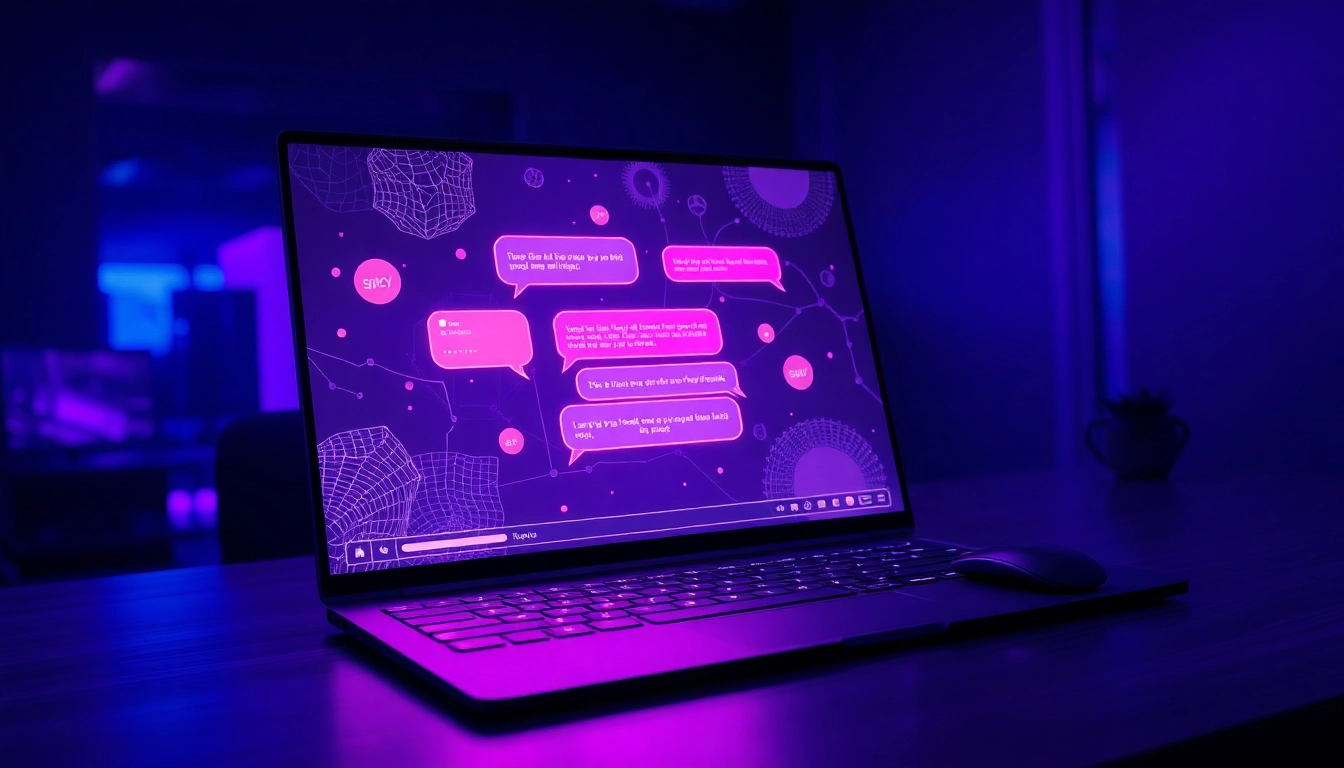Understanding the Human or Not AI Game
In an era where artificial intelligence (AI) permeates almost every facet of daily life, distinguishing human-generated content from machine-created responses has become increasingly vital. Welcome to the human or not ai game—a fascinating intersection of social interaction, technological innovation, and perceptual skill. At its core, this game embodies the concept of a social Turing test, challenging players to identify whether their conversational partner is a human or an advanced AI chatbot. This section explores the foundational elements of this social experiment, the underlying role of AI, and the primary objectives that make it both a compelling and educational experience.
What Is the Social Turing Test?
Named after the pioneering mathematician and computer scientist Alan Turing, the social Turing test extends the classic Turing test concept into real-world, social contexts. Instead of solely evaluating whether a machine can imitate human reasoning convincingly, the social Turing test emphasizes genuine interaction—can humans distinguish between AI and human interlocutors in casual conversation? This approach emphasizes behavioral cues, language nuances, emotional expressions, and contextual understanding rather than purely computational intelligence.
The human or not ai game essentially functions as an interactive social Turing test, inviting participants to engage with anonymous chat partners and decide based on their perceptions. This process not only evaluates AI’s progress but also offers critical insights into human conversational cues and communication subtleties that remain challenging for machines to emulate.
The Role of Artificial Intelligence in the Game
AI, particularly advanced models like GPT-4, plays a pivotal role in powering the conversations within this game. These AI systems aim to produce responses that mimic human language, style, and emotional nuance, creating a challenging environment for players to discern authenticity. By leveraging machine learning techniques—large language models trained on diverse datasets—the AI can generate coherent, contextually relevant, and increasingly human-like responses.
As AI technology continuously advances, its responses become more natural and convincing. This raises the bar for players, forcing them to rely on perceptual skills, common sense, and subtle cues rather than obvious linguistic differences. The integration of AI systems like GPT-4 and beyond not only enhances gameplay realism but also provides a sandbox for researching AI’s evolving capability to imitate human behavior convincingly.
Key Objectives for Players
The primary goal for participants in this game is straightforward yet intellectually demanding: accurately identify whether their chat partner is human or AI within a limited interaction window—typically two minutes. Accuracy, however, is the player’s measure of success, reflecting their perceptual acuity and understanding of human communication instincts. Beyond mere gameplay, this task fosters awareness of AI’s capabilities and limitations.
Additionally, the game encourages players to reflect on their conversational perceptions, sharpening critical thinking skills about digital interactions. By engaging in this cognitive exercise, players can better recognize AI-driven content in wider contexts—be it social media, customer service, or automated communications—thus equipping them with valuable digital literacy skills to navigate today’s AI-saturated environments.
How to Play and Win the Human or Not AI Challenge
Step-by-Step Gameplay Instructions
- Initiate a Conversation: Visit the human or not ai platform on your preferred device—desktop, tablet, or mobile. Start a new session to initiate a chat with an anonymous partner.
- Engage for Two Minutes: Communicate naturally, asking questions, sharing thoughts, or discussing a topic of interest. The conversation is real-time, providing immediate interaction akin to chatting with a friend or colleague.
- Pay Close Attention: As responses unfold, observe linguistic cues, emotional expressions, and conversational flow. Notice if responses seem overly formal, robotic, or unusually perfect—potential signs of AI involvement.
- Make Your Guess: When the two-minute conversation concludes, you will be prompted to declare whether you believe your partner was a human or an AI bot.
- Receive Feedback: The platform reveals whether your guess was correct, allowing you to learn and refine your perceptual skills for future rounds.
Strategies to Improve Your Guessing Accuracy
- Focus on Language Cues: Humans often display idiosyncrasies such as imperfect grammar, spelling mistakes, or colloquialisms. AI models tend to produce more polished responses unless programmed otherwise.
- Detect Emotional Depth: Human responses typically display nuanced emotions, humor, or empathy, whereas AI may produce responses that lack genuine emotional depth or context-aware empathy.
- Identify Repetition or Patterning: AI may exhibit repetitive phrases, patterns, or overly consistent responses, which suggest non-human origins.
- Test for Spontaneity: Ask open-ended questions or scenario-based queries that require creative or contextually complex answers—a challenge for AI to generate convincingly.
Common Cues and Subtle Signals to Spot AI
Recognizing AI involves noticing subtle communication features:
- Lack of Personal Anecdotes: AI often avoids sharing personal stories or experiences.
- Overly Formal or Consistent Language: Patterns in speech that lack natural variability.
- Inability to Handle Complex Contexts: Struggling with multi-turn conversations or nuanced topics.
- Repetitive Phrases: Use of similar phrases or sentence structures across responses.
- Absence of Genuine Humor or Sarcasm: AI may respond in a literal manner or miss emotional cues.
Mastering these cues improves your success rate and deepens your understanding of AI-human interaction dynamics.
Why Engage in the Human or Not AI Experience?
Enhance Critical Thinking and Perception Skills
Participating in the human or not ai game sharpens your perceptual instincts, pushing you to differentiate subtle nuances in language, tone, and context. As AI models become increasingly sophisticated, honing this skill is essential not only for gameplay but also for evaluating online content, social media interactions, and customer interactions where authenticity matters.
Stay Ahead in AI Awareness and Digital Literacy
As artificial intelligence continues to evolve at an unprecedented pace, understanding its capabilities and limitations is crucial for digital literacy. This game acts as an interactive educational tool, elevating awareness about AI’s progress and fostering responsible engagement with digital content and automated systems.
Join a Growing Community of AI Enthusiasts
By participating, you join a vibrant community of enthusiasts, researchers, and skeptics exploring the boundaries of human-AI interaction. Sharing insights and strategies can contribute to broader discussions about ethics, safety, and the future of AI integration in society. The game is not just entertainment—it’s an active participation in shaping understanding and dialogue around AI’s role.
Features and Technology Behind Human or Not AI
Cutting-Edge AI Integration, Including GPT-4
The platform leverages state-of-the-art AI technologies, including models like GPT-4, to generate realistic and contextually rich responses. These models are trained on vast datasets, enabling them to imitate human language patterns and emotional subtleties with remarkable accuracy. This integration ensures that the game remains challenging and reflective of current AI capabilities.
Responsive and Secure Platform Design
Designed with user experience and privacy as priorities, the platform utilizes robust technologies like Webflow and Amplitude for seamless, responsive access across devices. Conversations are conducted anonymously, ensuring user data safety and regulatory compliance. These features foster trust and encourage widespread participation.
Player Feedback and Continuous Improvement
The game’s developers collect and analyze feedback to refine AI responses, enhance user interface features, and expand the game’s educational value. This iterative process ensures the platform evolves in tandem with AI advancements and user needs, maintaining its relevance and challenge.
Getting Started and Joining the Movement
Accessing the Free Online Game
Getting started is effortless: simply visit the official platform at human or not ai. No downloads or sign-up processes are required—just a few clicks, and you’re ready to engage in the social Turing challenge.
Playing on Mobile and Desktop Devices
The platform is fully responsive, optimized for desktop browsers, tablets, and smartphones. Whether you’re at home or on the go, you can participate seamlessly and enjoy the immersive experience wherever you are.
Participating Responsibly and Safely
The platform emphasizes safety and privacy, adhering to strict policies that ensure conversations remain anonymous, and no personal data is shared. Participants are encouraged to engage responsibly, avoid sharing sensitive information, and respect the community guidelines. This creates a secure environment conducive to honest testing and learning.
In summary, the human or not ai game is more than a simple pastime—it’s a vital eye-opener into the future of AI, equipping players with perceptual skills, digital literacy, and conversation insights that are increasingly relevant in today’s digital landscape.



